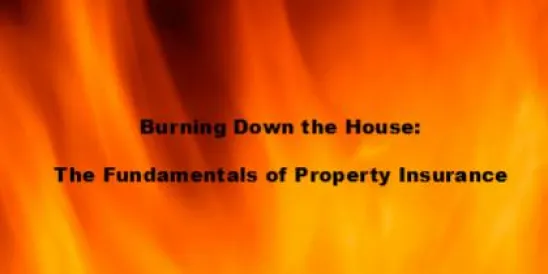Basic Form. Broad Form. Special Form. What do these terms mean? Is there a difference between them? Absolutely. If you are ignoring these terms when you are reviewing a lease or purchasing insurance coverage, you are at risk of obtaining the wrong kind of property insurance or insufficient coverage.
Who is Covered
Property insurance is coverage for the owner of property and will compensate the owner for any loss, damage, or destruction resulting from a covered peril. Unlike other forms of insurance (commercial general liability (CGL) insurance, for one), additional insureds cannot be added to property insurance.
Type of Coverage
- Basic Form – covers basic perils, including fire, lightning, explosions (but not boilers), windstorms, hail, smoke, vehicles (but not the insured's vehicles), riots or civil commotions, vandalism (but not glass breakage or theft), sprinkler leakage, sinkhole collapse, and volcanic action (but not earthquakes).
- Broad Form – covers those perils included in the Basic Form, plus glass breakage, falling objects, weight of snow, ice, or sleet, some water damage, and certain kinds of collapse.
- Special Form – covers any cause of loss, except those that are specifically excluded in the policy. Some typical exclusions include earth movement, nuclear hazards, flood, wear and tear, settling, insects, birds, rodents, mechanical breakdown, and war and military action. "Special Form" coverage was previously referred to as "All Risk" insurance. This term is no longer used by insurance companies and should be removed from your leases.
Amount of Recovery
- Actual Cash Value – the value calculated by subtracting depreciation from replacement cost of the property.
- Replacement Cost – the value calculated by determining the cost to replace the old property with new property of like kind and quality with no deduction for depreciation. This is the most common coverage requested by owners and is generally more expensive to obtain than actual cash value coverage.
Co-Insurance
Most forms of property insurance contain co-insurance provisions. What does this mean? This is a penalty that is incurred if the insured does not maintain adequate insurance to cover the value of the property. In the event of a loss, if the property is under-insured, any payment made to the insured is reduced in accordance with the co-insurance percentage. For instance, if the insured property has a replacement cost of $100,000 and a 90% co-insurance clause, the insured is required to obtain at least $90,000 in coverage or the penalty will be applied.
An owner should be careful to obtain the insurance sufficient to cover the value of the property in order to avoid application of the co-insurance penalty. In the alternative, the insured and the insurance company can stipulate to an agreed amount (i.e., value) of the property. If this "agreed amount" endorsement is obtained, then the co-insurance provisions will not apply. However, an owner should be cautious in obtaining this endorsement. While stipulating to an agreed amount may avoid the co-insurance penalty, the agreed amount may not be enough insurance coverage to replace the property in the event of a loss.
Waivers of Subrogation
Waivers of subrogation rights are commonly required in leases, and they are usually mutual (i.e., both the landlord and the tenant are waiving rights). What does this really mean? An insurance carrier normally has the right to assume the role of an insured after it pays a loss and attempt to recover from the person or party who was actually responsible for the loss. This is an insurance carrier's right of subrogation. When a lease requests that the insurance carrier waive its subrogation rights, it means that the insurance carrier is waiving the right to recover the funds paid to its insured from a third party. Will your insurance carrier let you waive these rights? Most insurance carriers will only permit their insureds to waive the right of subrogation if the waiver occurs before a loss and if the insurance carrier is notified of the waiver in advance.





 />i
/>i

